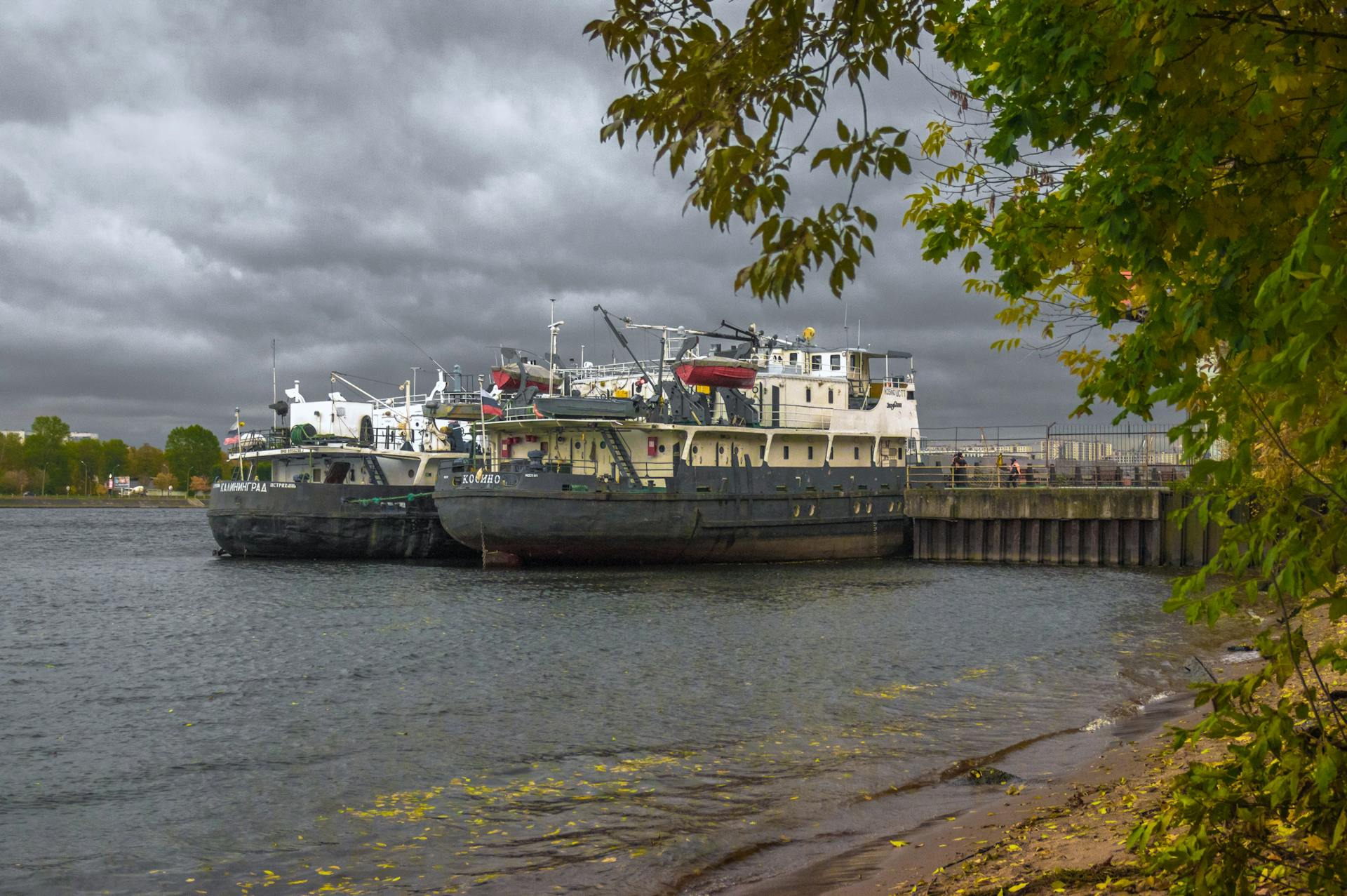
Loading dock covers can make a significant difference in your operational efficiency. They reduce heat loss in cold storage facilities by up to 90%.
By installing a loading dock cover, you can save on heating costs. This is especially beneficial for companies that rely on consistent temperatures to store perishable goods.
In addition to energy savings, loading dock covers also protect against the elements. They keep rain and snow out of the facility, reducing the risk of water damage and slips.
A well-designed loading dock cover can also improve safety. It prevents accidents caused by falling objects and reduces the risk of injuries from forklifts and other equipment.
Types of Seals
Loading dock seals and shelters come in various types to suit different needs and spaces.
One type of loading dock seal is the foam curtain loading dock seal, made from durable padding that creates an airtight seal between the trailer and building upon contact.
Retractable dock shelters are another option, retracting upon impact with the trailer to protect the shelter from damage if hit by a poorly aligned trailer.
Soft-sided shelters act as both a seal and shelter, similar to retractable dock shelters in that they will yield to impact from an off-center trailer to avoid damage.
Rigid shelters feature top and side curtains that flex inward, conforming to the trailer as it backs into the shelter, providing a fairly tight seal.
What is a Seal?
A loading dock seal is an exterior structure that surrounds a loading dock door to provide a tight closure between the loading dock opening and the trailer.
It protects the trailer and both the interior and exterior of the building from damage. The tight seal keeps water and pests out.
Loading dock seals feature a compression design, which provides a gasket-type seal between the sides and top of the trailer and the building.
A seal is generally airtight, unlike a shelter, which doesn't offer this level of closure.
Explore further: Cargo Trailer Cover
Benefits of Seals
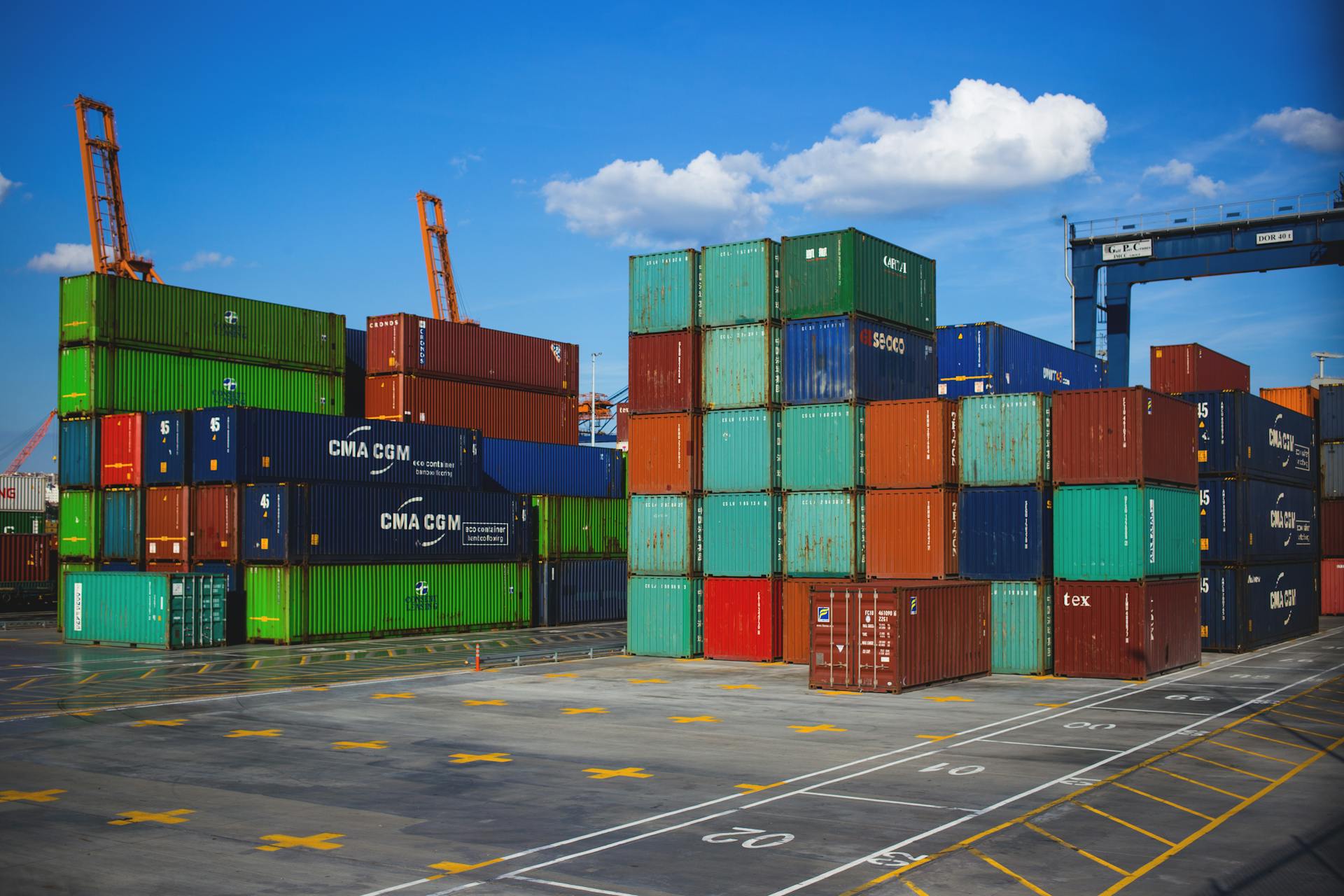
Loading dock seals offer many safety and financial benefits. They protect the trailer and both the interior and exterior of the building from damage.
A tight seal keeps water and pests out, which can help reduce energy costs by maintaining consistent temperatures. This is especially important in warehouses where energy efficiency is crucial.
Loading dock seals can significantly reduce energy costs by maintaining consistent temperatures. This is a major advantage for businesses looking to save money on their utility bills.
The most common types of loading dock seals feature a compression design, which provides a gasket-type seal between the sides and top of the trailer and the building.
Security and Safety
Loading dock seals play a crucial role in preventing unauthorized entries and stolen goods by minimizing gaps between the building and the trailer.
Intruders can't enter buildings and trailers, and valuable merchandise is protected from being stolen.
Loading dock seals also create a safer environment for workers in the loading dock area by keeping floors dry and protecting against high winds that can cause workers to lose their balance.
This is especially important in wet areas where slip-and-fall injuries can occur.
Explore further: Loading Dock Door Seals
Types of Seals
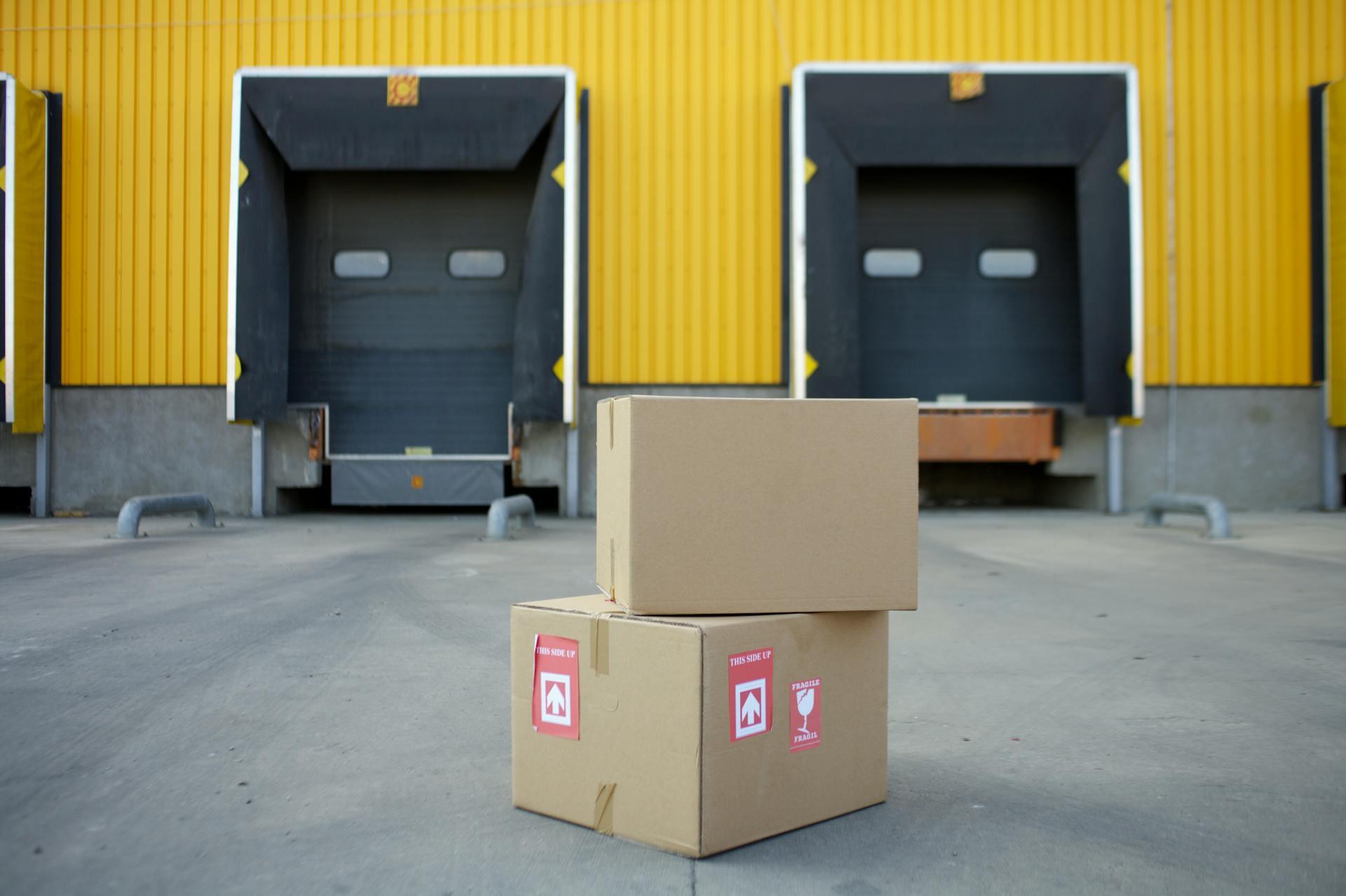
Foam curtain loading dock seals are a popular option, made from durable padding that creates an airtight seal between the trailer and building upon contact.
These seals are effective, but they can be damaged if hit by a poorly aligned trailer. Retractable dock seals are a better choice in this situation, as they retract upon impact with the trailer, protecting the shelter from damage.
Soft-sided shelters are another option, acting as both a seal and shelter. They yield to impact from an off-center trailer to avoid damage, making them a flexible and practical choice.
Rigid shelters feature top and side curtains that flex inward, conforming to the trailer as it backs into the shelter, providing a fairly tight seal.
Here are some key features of each type of seal:
Enhanced Security Against Unauthorized Entries and Theft
Loading dock seals minimize gaps between the building and the trailer, preventing intruders from entering buildings and trailers and leaving with your valuable merchandise.
This added security measure helps to safeguard your business from theft and unauthorized access.
Safer Work Environment
Creating a safer work environment is crucial for the well-being of your employees. Loading dock seals play a significant role in this by keeping floors dry, which reduces the risk of slip-and-fall injuries.
High winds can cause workers to lose their balance when loading or unloading trucks, but loading dock seals protect against this by keeping strong gusts of wind out. This helps prevent accidents and ensures a smoother operation.
Loading dock seals also protect workers from pest-borne illnesses by keeping bugs and pests from getting inside the warehouse. This is especially important in areas where pests can spread diseases.
By keeping the outside elements from entering the warehouse, loading dock seals also help protect your building's infrastructure and inventory. This can save you money in the long run by reducing maintenance and replacement costs.
Intriguing read: Climate Controlled Warehouse Loading Dock
Survivor
The Survivor dock shelter is a top-notch option for anyone looking to protect their loading dock area. It features a C-4-style head curtain, impactable side frames, and a V-Flow fabric header, making it a sturdy and reliable choice.
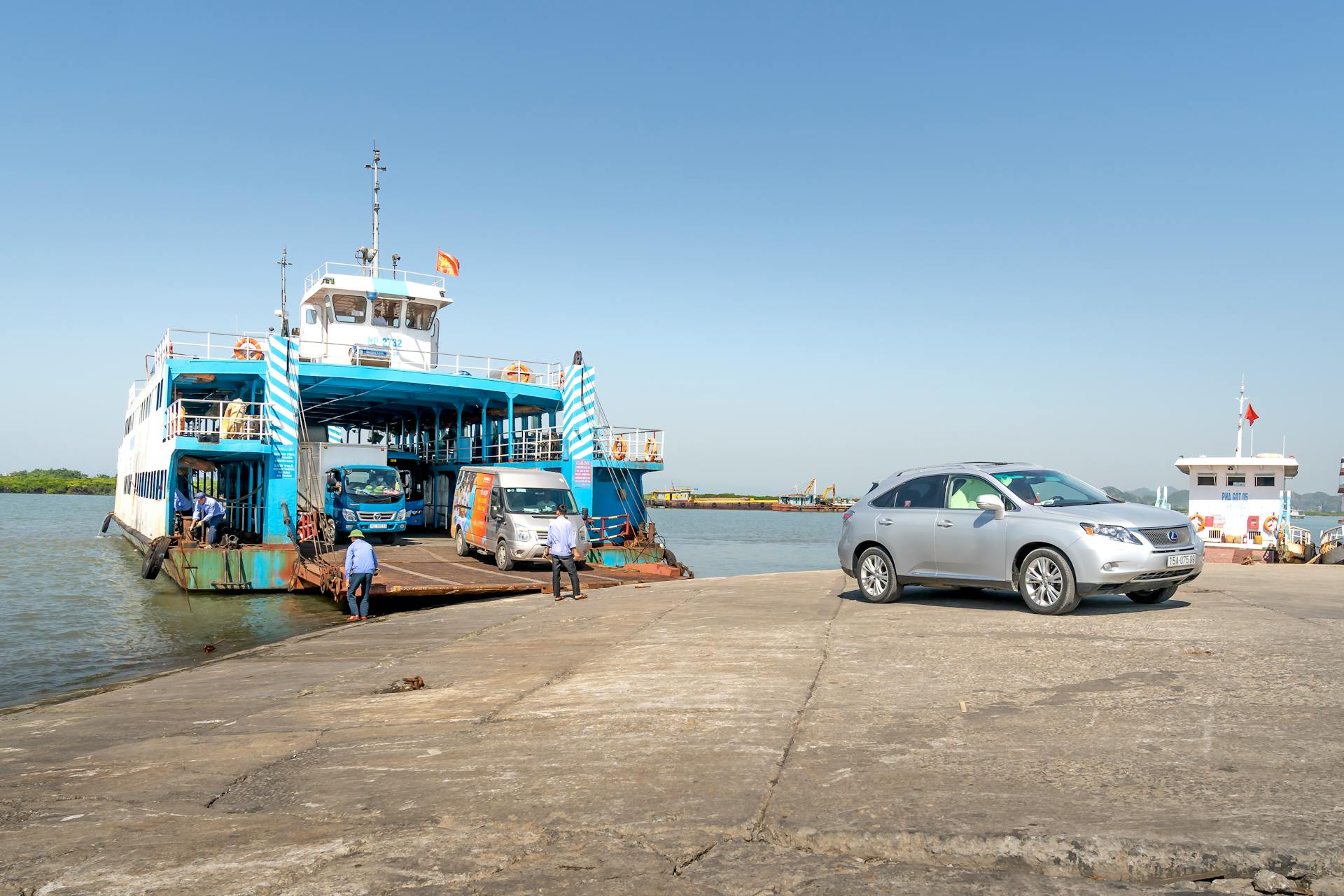
One of the standout features of the Survivor dock shelter is its ability to deflate and retract, making it easy to store and transport. This is especially useful for businesses with limited storage space.
The Survivor dock shelter is also designed for easy installation, which is a major plus for those who may not have a team of professionals on hand to do the job. Fast and reliable inflation is another key benefit, ensuring that the shelter is always ready to go when you need it.
If you're considering a Survivor dock shelter, here are some key features to keep in mind:
Energy Efficiency
Loading dock covers can significantly reduce your facility's energy costs by keeping heat out in the summer and cold out in the winter. This can lead to substantial savings, with some experts estimating that failing to close the gaps between loading dock doors and trailers can cost companies more than $1,200 per dock in lost energy costs per year.
Check this out: Loading Dock Energy Efficiency
An airtight seal is key to energy efficiency. By investing in a high-quality loading dock cover, you can ensure that your facility remains well-insulated and your energy bills stay low.
Not only do loading dock covers save energy, but they also help reduce waste and improve overall operations. By keeping your facility at a consistent temperature, you can extend the lifespan of your equipment and reduce the need for frequent repairs.
Loading dock covers are a simple yet effective solution for improving energy efficiency.
Operational Efficiency
Operational efficiency is crucial in any warehouse, and loading dock covers play a significant role in achieving it.
By eliminating potential hazards, workers can focus on their tasks without interruptions. Workers no longer need to avoid puddles or worry about dangerous gaps near the trailer, which can slow them down.
With a loading dock cover, maintaining an optimal temperature in the loading dock area becomes easier, making workers more comfortable and productive.
Increased Operational Efficiency
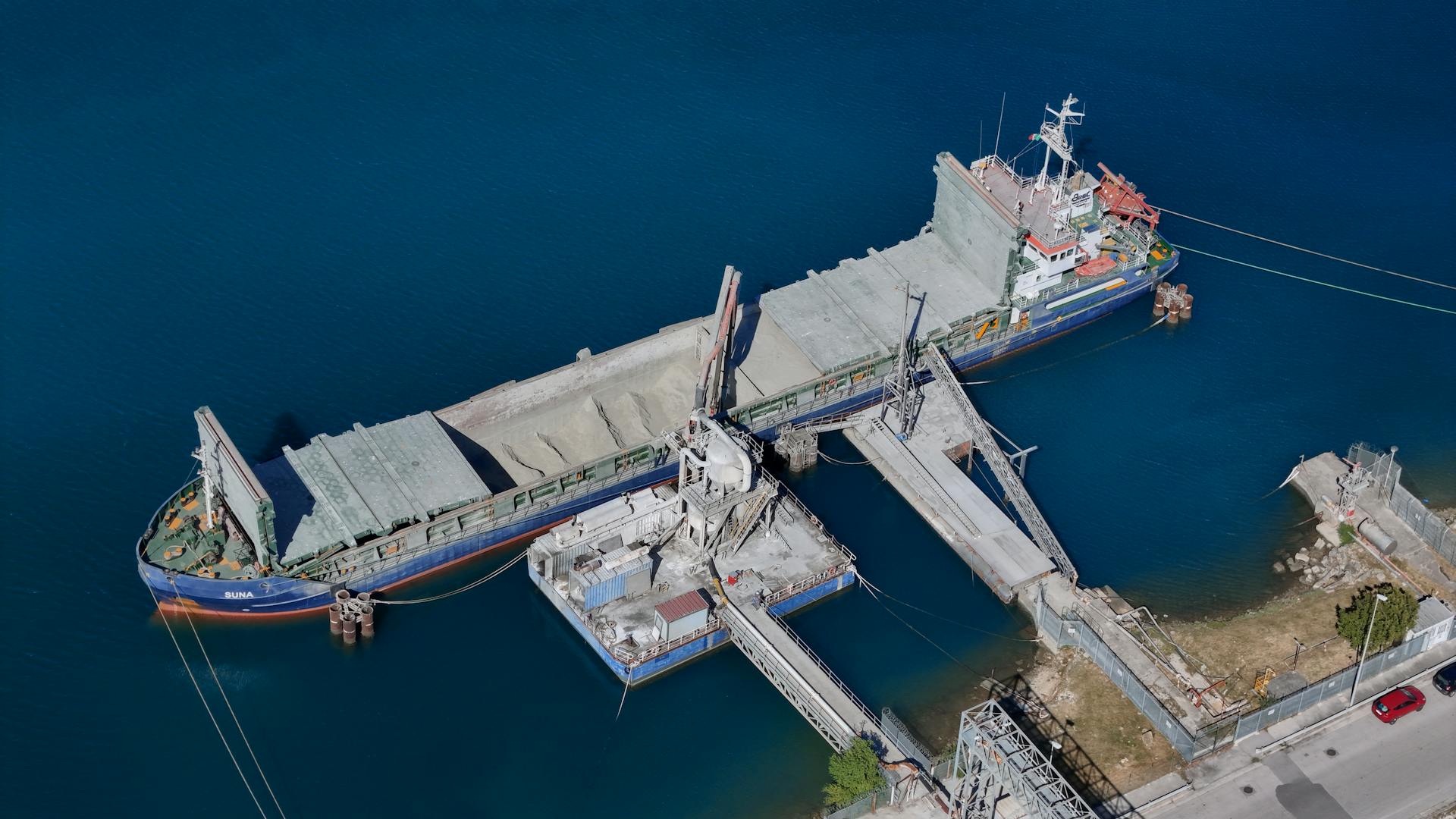
A loading dock is one of the busiest areas in every warehouse, and it's a place where efficiency can make a big difference.
Loading dock seals eliminate potential hazards that can slow workers down.
Workers don't have to worry about puddles or dangerous gaps near the trailer, which can slow them down and cause accidents.
Maintaining an optimal temperature in the loading dock area is easier with loading dock seals, making workers more comfortable and productive.
This can lead to increased productivity and efficiency in the warehouse.
Here are some key features of a dock shelter that can contribute to increased operational efficiency:
- Detachable side curtains
- Foam side frames
- Pivoting canopy header
Roll Formed Systems (Overhead & Outrigger Supported)
Roll Formed Systems (Overhead & Outrigger Supported) can be a cost-effective way to provide reliable entrance coverage. These systems are available in both overhead and outrigger configurations.
They offer a clean, professional appearance, making them ideal for budget-conscious projects. You can choose from basic color options like white, ivory, or bronze.
Check this out: Loading Dock Systems

In addition to these standard options, you can also opt for a Kynar wrapped fascia for a more premium look. Standard engineering capabilities are also available for these systems.
These systems are compatible with standard dock configurations, making them easy to integrate into existing infrastructure. They also maintain a clean appearance, which is essential for maintaining a professional image.
Here are some key benefits of Roll Formed Systems:
- Cost-effective entrance coverage
- Basic color options (white, ivory, bronze)
- Additional option for Kynar wrapped fascia
- Standard engineering capabilities
- Clean, professional appearance
- Ideal for budget-conscious projects
Eclipse
The Eclipse dock shelter is a game-changer for operational efficiency. It features advanced curtain sealing edges that ensure a tight seal, reducing air leaks and keeping your warehouse or facility at a consistent temperature.
Fabric sealing pockets are another key component of the Eclipse dock shelter, providing a secure seal that prevents air from escaping. This helps to maintain a stable environment, reducing the risk of damage to products and equipment.
Weighted head curtains are also a part of the Eclipse dock shelter, adding an extra layer of security to the sealing process. This helps to prevent air from escaping, even in windy or turbulent conditions.
Here are some key features of the Eclipse dock shelter:
- Fabric sealing pockets
- GapMaster hooks
- Weighted head curtain
GapMaster
The GapMaster dock shelter is a game-changer for operational efficiency. It's designed to keep the elements out, reducing energy costs and improving overall facility performance.
Failing to close the gaps between loading dock doors and trailers can cost companies more than $1,200 per dock in lost energy costs per year. This is a significant expense that can be avoided with the right equipment.
The GapMaster dock shelter features advanced technology, including GapMaster hooks and impactable side frames. These features work together to provide a secure seal and prevent energy loss.
A weighted head curtain is also a key component of the GapMaster dock shelter. This helps to maintain a tight seal and prevent air from escaping or entering the facility.
The Eclipse and GapMaster dock shelters both utilize fabric sealing pockets and weighted head curtains to achieve a tight seal.
Discover more: Loading Dock Shelter
Combo
In a combo approach, multiple operational efficiency strategies are combined to achieve maximum impact.
The combo approach was successfully implemented by a manufacturing company that saw a 25% reduction in production time and a 30% increase in productivity.
By streamlining processes, automating tasks, and implementing just-in-time inventory management, the company was able to optimize its workflow and reduce waste.
This combo approach is particularly effective in industries where multiple processes are intertwined, making it difficult to isolate and optimize individual components.
For example, a hospital that implemented a combo approach to patient care, including lean principles, six sigma, and total quality management, saw a significant reduction in patient wait times and a 20% decrease in hospital-acquired infections.
Canopy Options
If you're looking for a loading dock canopy that provides maximum coverage, the Bullnose Loading Dock Canopy is a great option, with a 24-inch fascia height that offers the most coverage of any dock canopy solution.
This canopy features a distinctive curved front edge that adds architectural interest to large building elevations, and it's available in 25+ standard color options to match your building's aesthetic.
Consider reading: Loading Dock Canopy
You can choose from a variety of fascia heights with the Outrigger Loading Dock Canopy, which offers a lower profile than the Bullnose model, with either a 12 or 14 inch fascia height.
Both the Bullnose and Outrigger canopies are built with engineered aluminum and steel construction, ensuring durability and reliability, and they both feature a built-in drainage system to keep your loading dock area dry.
Here are the key features of our loading dock canopy options:
Canopies
Canopies provide essential protection from the elements, and Pierre Construction Group offers a range of options to suit various needs and budgets.
Their loading dock canopies are designed for functional protection, with three distinct options to choose from, each tailored to meet specific specifications and budget requirements.
Whether you need a cost-effective solution for basic specifications or a premium system for high-traffic areas, Pierre Construction Group has a canopy option that fits the bill.
A different take: Loading Dock Fall Protection
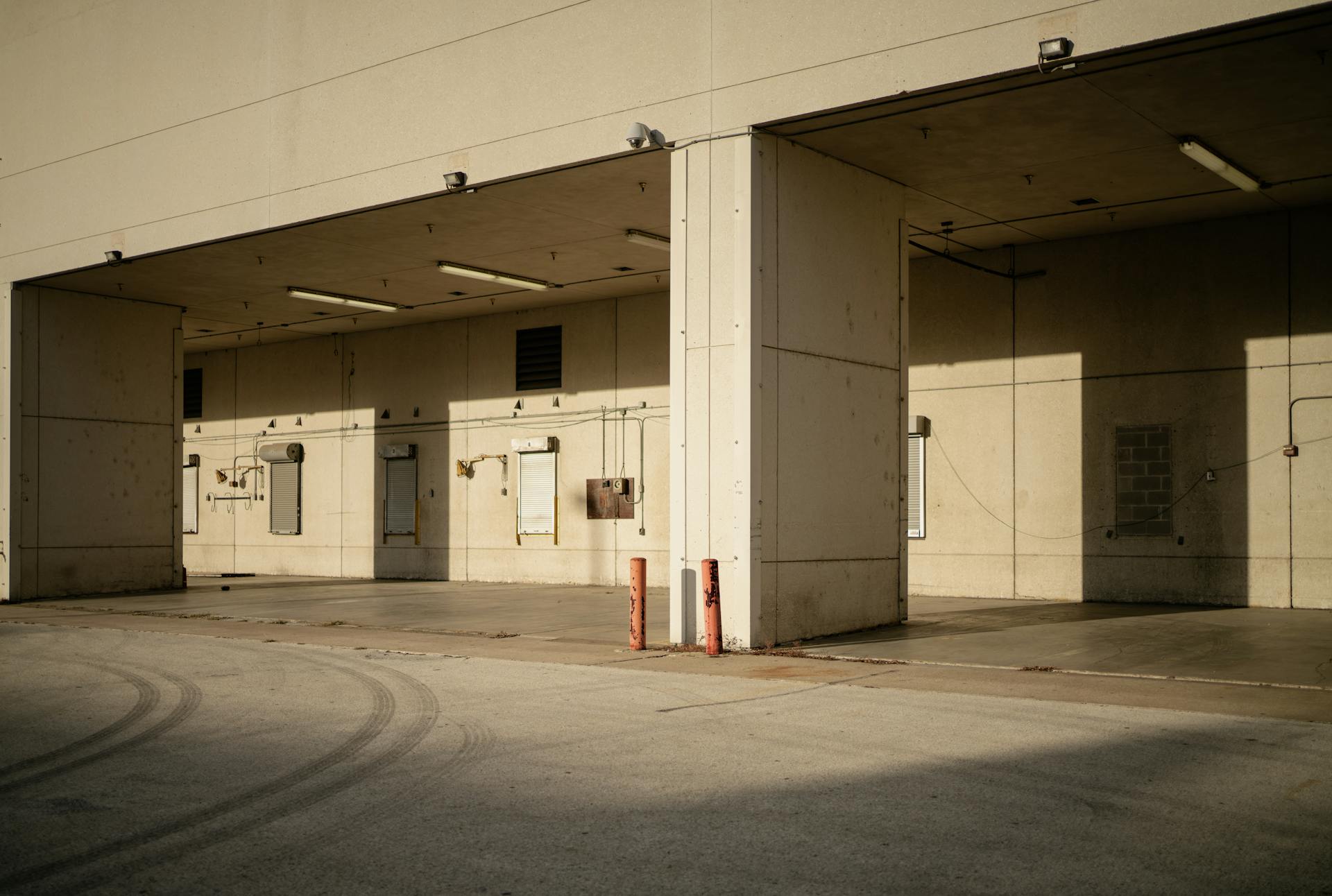
Here are some key features of their loading dock canopies:
Their canopies are designed to provide reliable weather protection, with options ranging from economical to premium, and each one is engineered to meet specific architectural requirements.
Pierre Construction Group's canopies are built to last, with durable materials and designs that can withstand harsh weather conditions.
Their Roll Formed Systems offer a cost-effective alternative to extruded systems, providing reliable coverage with basic finish options and a clean, professional appearance.
Extruded Overhead Supported
For a premium entrance canopy, consider the Extruded Overhead Supported option. This style features a powder-coated finish in a wide range of colors.
The tie-rod support system provides superior load capacity, making it an excellent choice for high-traffic areas. This system is engineered for maximum span capability, ensuring a sturdy structure.
Multiple fascia height options are available, including 6”, 8”, 10”, and 12”. This flexibility allows you to choose the perfect fit for your entrance.
Clean architectural lines give this canopy a sleek and modern appearance. It's ideal for main entrances and high-visibility areas, making a great first impression.
Product Details
A loading dock cover is a crucial investment for any warehouse or commercial facility. It protects the dock area from the elements and helps maintain a clean and safe environment.
The construction of a loading dock cover is sturdy, with a heavy-duty structural framework that supports the top and side curtains. This framework is typically made of treated wood, but optional steel structural framework is available for added durability.
The projection of a loading dock cover is also important to consider. It's recommended to have a projection of at least 12 inches beyond the bumper or point of no further progress to ensure proper function. Less than 12 inches won't allow for a smooth entry and exit for trucks.
Mounting a loading dock cover is relatively straightforward, and the mounting hardware is usually supplied with each unit. The hardware is cadmium plated for added durability and corrosion resistance.
You can choose from a variety of colors for your loading dock cover, including standard black, as well as grey, green, and tan options. A safety yellow guide strip is also a standard feature to help with visibility.
Here are some common options for loading dock covers:
- 40 oz. neoprene coated nylon - black
- 40 oz. Hypalon coated nylon - black
- 40 oz. polyurethane coated nylon - black
- 22 oz. vinyl coated nylon
- Guardian Pleat on the wear point of the head curtain
Standard material for loading dock covers is 40 oz. vinyl coated nylon. However, due to supply chain disruptions, inflation, or material shortages, tariffs or surcharges may apply to current published pricing, and some longer lead times may be incurred.
Design and Installation
There is no one-size-fits-all approach to designing the right loading dock layout, as it depends on the truck drive approach outside of the building.
Accounting for this is crucial when selecting a loading dock cover, as it affects the overall functionality and efficiency of the dock.
A standard loading dock layout typically has a truck drive approach outside of the building, which should be taken into consideration when choosing a loading dock cover.
Expand your knowledge: Loading Dock Truck Ramps
Improve Door Life
Improving the life of your doors is crucial, especially for loading dock doors which are exposed to harsh elements like rain, snow, and wind.
Adding a loading dock seal can greatly reduce excess wear and tear on your doors.
A metal canopy above the door can also minimize the impact of elements, prolonging the lifecycle of your doors.
By taking these simple steps, you can extend the life of your doors and avoid costly repairs down the line.
WG-410 Rigid Frame
The WG-410 Rigid Frame is a reliable choice for many applications. It features a C-4-style head curtain, which provides a secure seal.
A raked header is also a notable feature of this design. This allows for better airflow and reduces the risk of moisture buildup.
Rugged ArmorPleats are used to reinforce the curtain, making it even more durable. This is especially important in harsh environments.
Deflation and retraction are also possible with the WG-410 Rigid Frame. This makes it easier to maintain and repair the system.
The durable and low-maintenance design of the WG-410 Rigid Frame is a major advantage. It requires less upkeep than other similar systems.
In fact, the WG-410 Rigid Frame boasts the tightest railcar seal available. This helps to prevent leaks and ensures a secure seal.
You might enjoy: Concrete Loading Dock Design
Designing for Your Operation
There is no one-size-fits-all approach to designing a loading dock layout, so it's essential to consider the specifics of your operation. Accounting for the truck drive approach outside of the building is a crucial factor.
A standard loading dock layout may not be suitable for every business, and custom designs can be more effective. The truck drive approach outside of the building is a key consideration in designing the right loading dock layout.
Explore further: Automated Pallet Truck
The Problem at Your
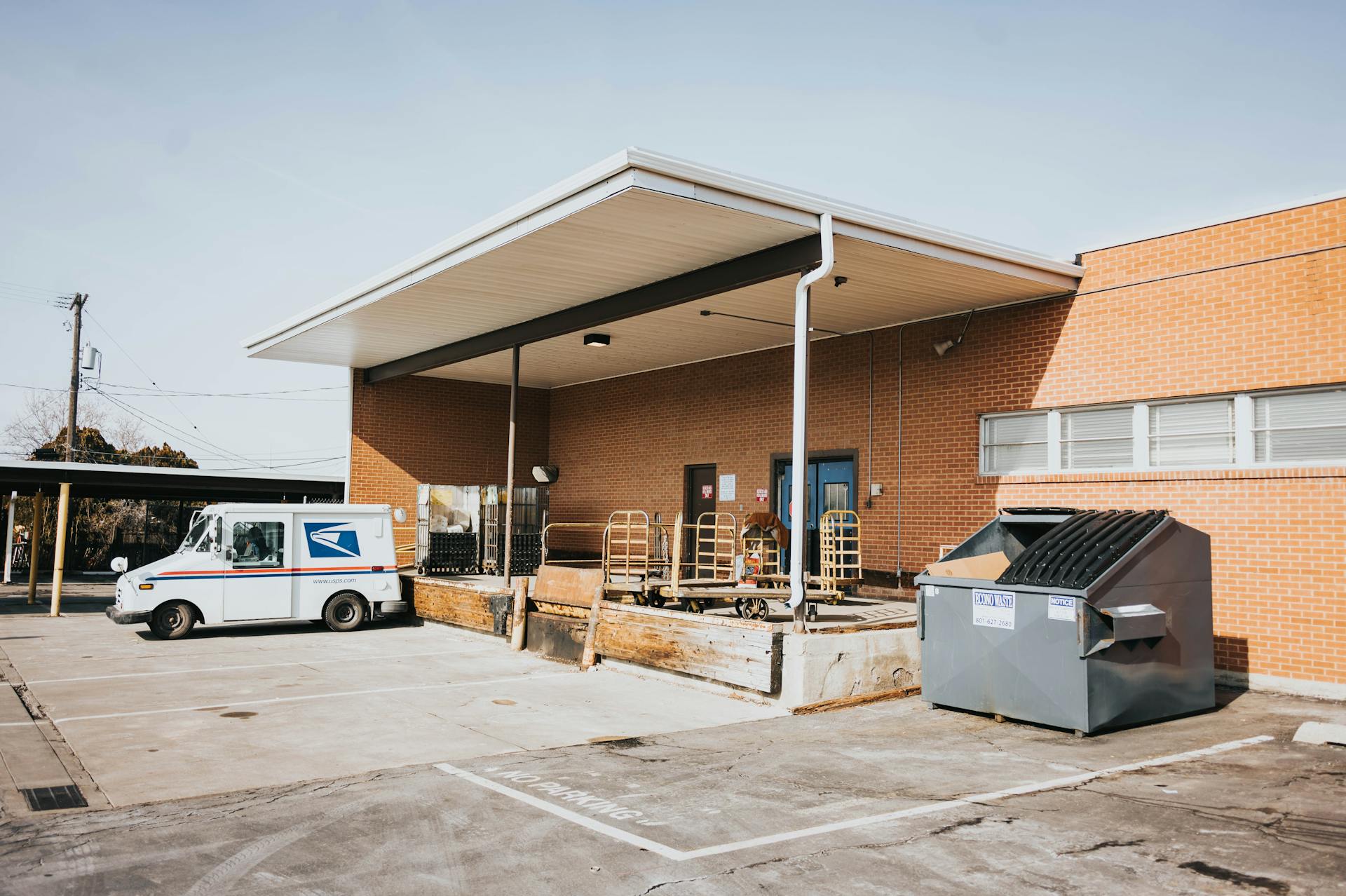
You have a glaring problem at your loading dock, areas of bright light visible around the trailers backed into each position. This light indicates gaps where trailers are not fully secured to the dock.
These gaps can lead to accidents and injuries, and also compromise the security of your facility. You need to address this issue to ensure a safe and secure environment.
A common problem at loading docks is the presence of gaps between the trailer and the dock. This can be due to a variety of factors, including uneven dock surfaces or trailers that are not properly secured.
To minimize these gaps, it's essential to ensure that the dock is properly installed and maintained. This includes regular inspections and repairs to prevent damage and ensure a smooth operation.
Frequently Asked Questions
What should you use to cover a gap between a truck and a loading dock?
To safely load or unload trailers, use dock plates, dockboards, or dock levelers to bridge the gap between the truck and loading dock
What is the most common cause of injury at a loading dock?
The most common causes of injury at a loading dock include vehicle collisions, back injuries from lifting heavy objects, and slip and fall accidents. These hazards can be prevented with proper training, equipment, and safety protocols.
Sources
- https://www.curtain-and-divider.com/product/loading-dock-curtains/
- https://upsideinnovations.com/blog/improve-safety-and-prevent-weather-damage-with-loading-dock-seals/
- https://pierreconstruction.com/architectural-metal-solutions/canopies/
- https://www.beacontechnology.com/dock-equipment/dock-door-seals/dock-door-shelters/
- https://www.ritehite.com/en/am/products/dock-seals-and-shelters/dock-shelters
Featured Images: pexels.com

